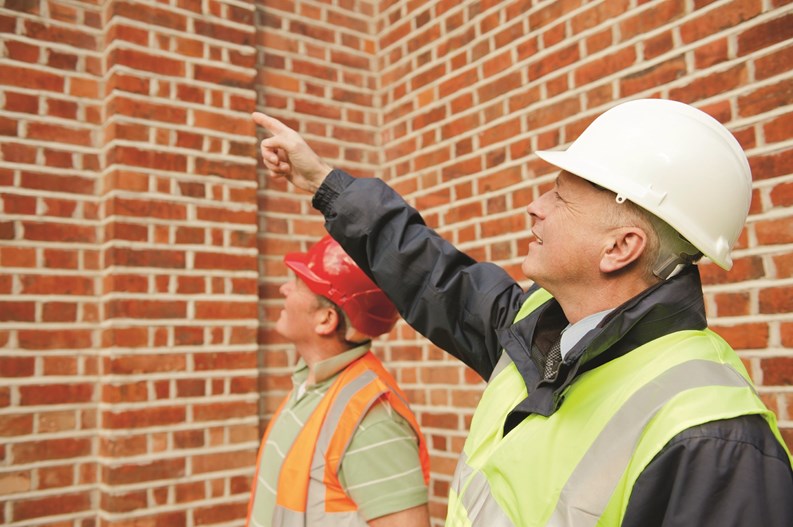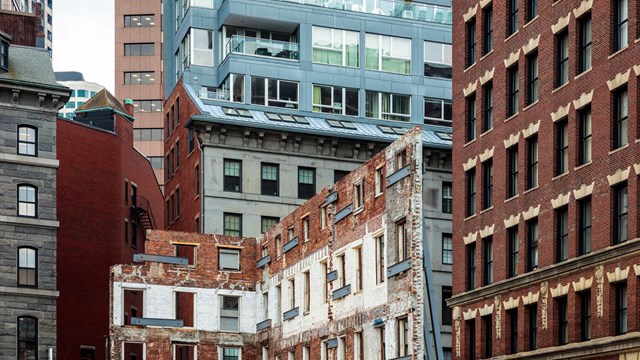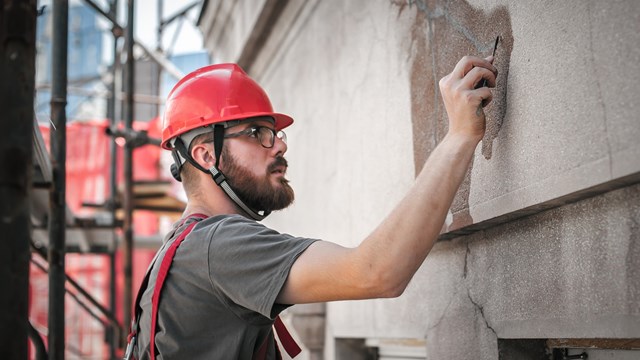Exteriors of buildings aren’t always smooth brick walls. There are all sorts of indentations and protrusions, from terraces to stonework to cornices. There are also items that are not part of the building, but are affixed to it, like scaffolds and window air conditioners. And if such items are poorly secured or loose, it could lead to disaster.
In New England, where the populace is all too familiar with nor'easters and the ice, snow and wind devastation that can be inherent therein, securing exteriors is quite important. If something is loose on the outside of a building, a particularly brutal gust can make the exterior facades vulnerable, whether you’re in a city or the suburbs. There are also other causes of incidents, such as construction accidents or material that comes loose after a number of years from weather, wear and tear.
Consider these happenings along the East Coast over the past few years:
In May 2015, a two-year old New York City girl died after terra cotta bricks from a crumbling Upper West Side Manhattan building rained down on her and her grandmother.
Last June, four New Jersey residents were injured when bricks fell from a second-floor façade of a building. The mayor, who is also a doctor, ran from his nearby office and helped the victims.
In June, residents of the Venetian Isles residential complex in Leesburg, Florida were evacuated after strong winds tore through a roof.
And in February, after several weeks of snow accumulation, multiple buildings collapsed around the state of Massachusetts, their roofs no longer able to sustain that added weight.
There is a litany of material and devices that are often affixed to, installed on, or exist as part of a building which, under certain hazardous conditions, can loosen and cause a maelstrom of chaos. Douglas Thayer, the president of Thayer & Associates, Inc. in Cambridge, Massachusetts, lists but a few:
• Cell towers & related equipment
• Masonry or metal chimneys
• Lightning rods
• Ventilation ducts
• Rooftop exhaust fans
• Bathroom ducts & louvers
• Dryer vents
• Cable television wiring (one of Thayer's personal pet peeves, it should be noted)
• Exterior light fixtures
• Signs
• Flags & flag poles
• Anti-fall protection systems (the irony)
• Surveillance cameras
• Awnings
• Ice & snow guards
• Elevator and mechanical penthouses
• Solar panels
• Decks and associated furniture
• Fire escapes and fire escape balconies
• Exterior stairs
• Window cleaning equipment (including motorized scaffolding)
• Stone cornices, masonry water tables and other architectural masonry features
• Parapet walls
• Window grates
Basically, more things on the outside of a condo property are liable to cause trouble than aren't, so security of same is no joke. Even on the sunniest of days, an association needs to secure its property as if a hurricane can roll in within minutes, for the benefit of owners, guests and the structure itself.
Outside Elements
State building code generally regulates the what's and how's regarding affixing items to the facade of a building, or hosting various apparatuses on a roof. In Massachusetts, for example, the code is ever-evolving, and is based on several factors. One such item taken into account when drawing up legislation is, unsurprisingly, weather.
Howard Goldman, a partner with Goldman & Pease in Needham, MA, notes but one way that nor'easters can damage or weaken condo exteriors. "Some units have their own HVAC units with vents on the outside," he explains. "In the event of a storm, the wind is whipped and thrown into the vent, and if the HVAC isn't properly sealed, water can enter the utility, causing mold and mildew. The strong wind that stems from the ocean can cause rain to strike these HVAC exhaust vents horizontally, exposing any weaknesses. This also applies to roof soffits—wind can force itself into those, leading water to develop into ice dams. When this ekes through, it can expose poor installation.
As to how this impacts policy, Stephen Marcus, a partner with Marcus, Errico, Emmer & Brooks, P.C. in Braintree, Massachusetts, notes that, in a 2004 report on building performance, FEMA addressed the above topic, and many others, taking special note of the fallibility of exterior electrical equipment mounted on roofs. The report notes that, in event of a storm, essential equipment attached to buildings often failed "as a result of non-existent or inadequate anchoring. Displaced equipment frequently left large openings through the roof, or punctured the roof membrane, allowing rain water to infiltrate the building. Widespread soffit damage was observed throughout the areas impacted [by storms], resulting in unnecessary rain water intrusion into building interiors." So while it may be essential to house equipment that is crucial to a property's functionality on the exterior, an association must be meticulous to ensure that this equipment is properly sealed to the extent that harsh New England weather—especially during the winter—won't send unsavory elements into the building envelope, causing erosion from the inside out.
And, as wind is such a frequent interloper amid usually tranquil condo-living, boards should make sure that residents know to take any type of mobile appliances or furniture inside when strong gusts are in the forecast. Marcus recommends that patio furniture, flags, grills and items of this nature be closely monitored and fastened or stored before they can become weapons of destruction.
Every Man Needs a Code
Out-of-ground construction projects need to be approved with permits proving that they adhere to state and international building code, ASCE requirements, and even the guidelines of American Society for Civil Engineers, depending on the rules in a given municipality. But, for the most part, once built in adherence with every applicable ordinance, it falls upon the board to successfully maintain a condominium property, and this naturally includes seeing to it that the exteriors remain safe and secure, at risk of stiff penalties.
“Ultimately property owners are responsible for maintaining, repairing and replacing the elements that make up the exterior facades of their buildings,” says Thayer. “They or their management companies should conduct periodic inspections and arrange for qualified, licensed and insured contractors to repair and secure any loose items. Also of note is that some municipalities mandate regular inspections by professional structural engineers.”
Should an owner fail to adhere to the above, consequences are introduced into the equation. Their severity depends on the nature of the inciting incident. “If the damage is foreseeable and items were not properly secured, it is likely that the event of property damage will result in a suit which would typically be covered by the master insurance carrier,” explains Marcus. “If an item fell from a unit owner’s balcony, and the association had instructed owners to bring deck or patio furniture indoors, then it’s likely that the association would not be liable for any damage, but the unit owner might be.”
As the board has a duty to secure items to an exterior or a roof, the standard charge for a failure to do so that results in property damage or bodily injury is negligence. Marcus recommends seeing to it that master insurance covers wind damage, and advises checking deductibles pertaining to same. “Deductibles for wind damage often hover around 5% of a policy’s face value, so they may be high,” he says. “Unit owners should consider wind damage and Loss Assessment Insurance and Coverage A, which relates to property damage owing to wind. It’s likely that liability for wind damage would be covered under the association’s liability policy, but it’s worth consulting with the master agent.”
And while the brunt of the responsibility falls to the association and property owners, Goldman cites a particular instance where a third party may assume some of the burden: “I’ve seen scenarios wherein an internet or cable service provider enters into a lease agreement with an association, via which they pay the condo rent every month to keep their antenna (and accompanying wiring) atop the property. I was on a roof recently where I was shocked to see how sloppily the wires were strewn about. Oftentimes, the roof is available to everyone, and if there’s a situation wherein there are poorly maintained wires that are neither properly hidden or protected, someone can trip and fall at a serious height. If someone gets hurt, there’s potential negligence at play. The association would have to plead the vendor—and there should be some language regarding indemnity in the agreement between the vendor and the association—for contribution in an ensuing legal suit.”
The best way to steer clear of an expensive and prolonged fallout from an incident is to avoid any damages— whether they be to a person or a property—entirely. While one can’t plan for every rainy day, consulting with a property manager and other vendors to make sure that everything affixed to a building’s façade or placed upon a roof is secure and up to code. And if an inspection goes off without a hitch, an association can’t rest on its laurels. Building codes evolve all the time. By staying abreast to the latest language— and via consultation with an association’s attorney—a board can ensure that its property is safe and secure for its residents and their guests.
Mike Odenthal is a staff writer for New England Condominium.







Leave a Comment